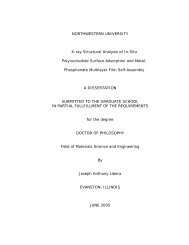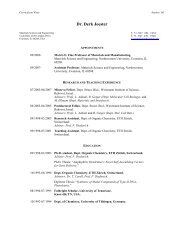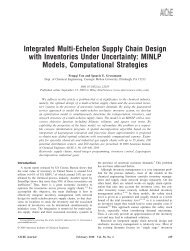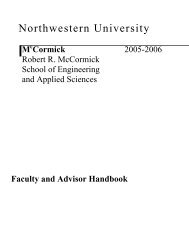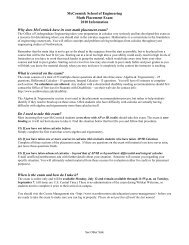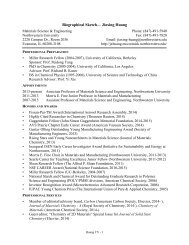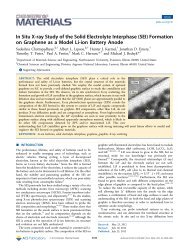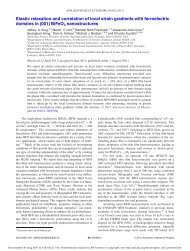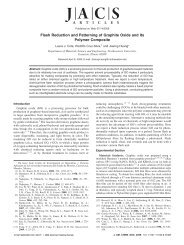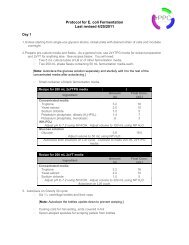Community-Based Operations Research - Humanitarian Logistics
Community-Based Operations Research - Humanitarian Logistics
Community-Based Operations Research - Humanitarian Logistics
You also want an ePaper? Increase the reach of your titles
YUMPU automatically turns print PDFs into web optimized ePapers that Google loves.
Johnson and Smilowitz: <strong>Community</strong>-<strong>Based</strong> <strong>Operations</strong> <strong>Research</strong>Tutorialsin <strong>Operations</strong><strong>Research</strong>, c○ 2007 INFORMS 1112.2.4. Public Education. Thanassoulis and Dunstan [85] show how data envelopmentanalysis (DEA) can be used to guide secondary schools to improved performance throughrole-model identification and target setting in a way that recognizes the multioutcome natureof the education process and reflects the relative desirability of improving individual outcomes.The approach presented in the paper draws from a DEA-based assessment of theschools of a local education authority carried out by the authors. Mar Molinero [64] developsrecommendations for school closures in a region with declining school-age population usingtechniques to measure the similarity of school catchment areas that are input to a multidimensionalscaling analysis that identifies socio-economic characteristics of these areas.Recommendations to close high-cost, low-performing schools that serve most-disadvantagedregions are contrasted with political opposition from local communities that seek to preservelocal educational opportunities. Bowerman [14] formulates a multiobjective modelfor urban school-bus routing that addresses efficiency and equity jointly, and develops atwo-phase approach combining student clustering and route generation. Taylor et al. [84]describe forecasting models for school attendance and optimization models for public-schoollocations and attendance boundaries, which reflect detailed knowledge of school administrators,elected representatives, and planners. These models address the need for racialbalance across schools to minimize the need for busing, and have increased the confidence ofcommunity stakeholders in the school planning process, as measured by decreased politicalopposition to siting plans and increased passage rate of funding referenda.2.3. <strong>Community</strong> Development2.3.1. Housing. Kaplan [49], Kaplan and Amir [53], and Kaplan and Berman [54] formulateand solve math programs related to production-scheduling problems to design policiesfor relocating families in public-housing communities undergoing renovations to minimizetotal development time while ensuring that as few families as possible are displaced frompublic housing into private markets. Kaplan [50] uses queuing theory to evaluate the impactsof race-based versus nonrace-based tenant-assignment policies in public housing on levels ofracial segregation and waiting times for available units. Forgionne [24] describes a decisionsupportsystem for assessing the army’s needs for on-base new construction or off-base leasedhousing, determined in part by estimates of the level of off-base affordable housing availableto its personnel.Johnson and Hurter [45] generate alternative potential allocations of households usingrental vouchers to Census tracts across a county to jointly optimize measures of net socialbenefit and equity, subject to constraints on programmatic and political feasibility. Estimatesof dollar-valued impacts of subsidized housing are derived from models adapted fromhousing economics that use observations of actual households. Johnson [43] solves a multiobjectivemodel for location of project-based affordable renter- and owner-occupied housing tooptimize social efficiency and equity measures. Objective functions and structural parametervalues are derived from discussions with nonprofit housing providers. Johnson [44] estimatesstructural parameters for math programming-based models for affordable housing designusing microeconomic models of the firm and of the consumer, and statistical methods suchas forecasting and factor analysis. Observations of housing units, households, and housingprojects are provided by community-based nonprofit housing developers.Johnson [39] presents a Web-accessible prototype of a SDSS for individual housing mobilitycounseling using multiple decision models and reflecting the needs of housing clients,counselors, and landlords. Johnson [42] provides a research framework for a professionalqualityhousing counseling SDSS and provides evidence derived from field research thattypical subsidized housing program participants can make productive use of quantitativedecision models. Both of these papers are discussed in greater detail in §3.



